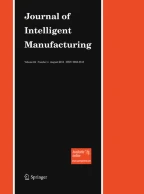Abstract
This paper proposes a spatial three degrees of freedom (DOF) parallel kinematic machine enhanced by a passive leg and a web-based remote control system. First, the geometric model of the parallel kinematic machine is addressed. In the mechanism, a fourth kinematic link—a passive link connecting the base center to the moving platform center—is introduced. Each of the three parallel limbs is actuated by one prismatic joint, respectively. The additional link has three passive DOF, namely two rotations around x and y axes and one translation along z axis. With the existence of this link, the unwanted motion of the tool (located in the moving platform) is constrained. The fourth link also enhances the global stiffness of the structure and distributes the torque from machining. With the kinematic model, a web-based remote control approach is applied. The concept of the web-based remote manipulation approach is introduced and the principles behind the method are explored in detail. Finally, a remote manipulation is demonstrated to the proposed structure using web-based remote control concept.
Similar content being viewed by others
References
Alvares A., Ferreira J., Lorenzo R. (2008) An integrated web-based CAD/CAPP/CAM system for the remote design and manufacture of feature-based cylindrical parts. Journal of Intelligent Manufacturing 19(6): 643–659
Apte N., Zeid I. (2002) Evolution of transparent manufacturing: An architecture for a java-based controller of a CIM cell. Journal of Intelligent Manufacturing 13(2): 89–100
Banda K., Zeid I. (2006) To disassemble or not: A computational methodology for decision making. Journal of Intelligent Manufacturing 17(5): 621–634
Boër, C. R., Molinari-Tosatti, L., Smith, K. S. (eds) (1999) Parallel kinematic machines: Theoretical aspects and industrial requirements. Springer, New York
Caccavale F., Siciliano B., Villani L. (2003) The tricept robot: Dynamics and impedance control. IEEE/ASME Transactions on Mechatronics 8(2): 263–268
Chen S. L., Chang T. H., Lin Y. C. (2006) Applications of equivalent components concept on the singularity analysis of TRR-XY hybrid parallel kinematic machine tools. International Journal of Advanced Manufacturing Technology 30(7–8): 778–788
Cheng H., Yiu Y., Li Z. X. (2003) Dynamics and control of redundantly actuated parallel manipulators. IEEE/ASME Transactions on Mechatronics 8: 483–491
El-Khasawneh B. S., Ferreira P. M. et al (1999) The Tetrahedral tripod. In: Boër CR (eds) Parallel kinematic machines: Theoretical aspects and industrial requirements. Springer, New York, pp 419–430
e-MNI. (2002). http://www.e-manufacturing.com/.
GE Fanuc. (2002). http://www.gefanuc.com/products/software/cimplicity_home.asp.
Gosselin C. M., Zhang D. (2002) Stiffness analysis of parallel mechanisms using a lumped model. International Journal of Robotics and Automation 17: 17–27
Hitachi Seiki. (2002). http://www.hitachiseikiusa.com/tradeshows/Westec/flexlink.html.
Honegger, M., Codourey, A., & Burdet, E. (1997). Adaptive control of the hexaglide, a 6 DOF parallel manipulator. In Proceedings of the 1997 IEEE international conference on robotics and automation, (Vol. 1, pp. 543–548).
Kochan A. (1996) Parallel robots perfect propellers. Industrial Robot 23(4): 27–30
Mazak. (2002). http://www.mazak.co.jp/English/sMT&IT/frame2-factory.html
MDSI Inc. (2002). http://www.mdsi2.com/products/opencnc.htm.
Mitchell J. H., Jacob R., Mika N. (2006) Optimization of a spherical mechanism for a minimally invasive surgical robot: Theoretical and experimental approaches. IEEE Transactions on Biomedical Engineering 53: 1440–1445
Nof S. Y. (2006) Collaborative e-work and e-manufacturing: Challenges for production and logistics managers. Journal of Intelligent Manufacturing 17(6): 689–701
Pierrot, F. (1998). From hexa to hexaM. International Parallel kinematik-kolloquium IPK’98, ETH Zurich, pp. 75–84.
Potapov V. A. (1996) Is success of new-concept machine tools possible?. Russian Engineering Research 16: 81–86
Pritschow G., Wurst K.-H. (1997) Systematic design of hexapods and other parallel link systems. Annals of the CIRP 46(1): 291–295
Pritschow G. et al (1999) Research and development in the field of parallel kinematic systems in Europe. In: Boër CR (eds) Parallel kinematic machines: Theoretical aspects and industrial requirements. Springer, New York, pp 1–16
Rao A., Rao P., Saha S. (2005) Dimensional design of hexaslides for optimal workspace and dexterity. IEEE Transactions on Robotics 21: 444–449
Refaat S., Herve J. M., Nahavandi S. (2007) Two-mode overconstrained three-DOFs rotational translational linear motor based parallel-kinematics mechanism for machine tool applications. Robotica 25: 461–466
Siciliano B. (1999) The tricept robot: Inverse kinematics, manipulability analysis and closed-loop direct kinematics algorithm. Robotica 17(4): 437–445
Sowizral H., Rushforth K., Deering M. (2001) The java 3D API specification. Addison-Wesley, Boston
Stock M., Miller K. (2003) Optimal kinematic design of spatial parallel manipulators: Application to linear delta robot. Journal Mechanical Design 125: 292–301
Suzuki M., Watanabe K., Shibukawa T., Tooyama T., Hattori K. (1997) Development of milling machine with parallel mechanism. Toyota Technical Review 47(1): 125–130
Tlusty J., Ziegert J., Ridgeway S. (1999) Fundamental comparison of the use of serial and parallel kinematics for machine tools. Annals of the CIRP 48(1): 351–356
Tönshoff, H. K., Soehner, C., & Ahlers, H. (1998). A new machine tool concept for laser machining. In Proceedings of international seminar on improving machine tool performance, San Sebastian, (pp. 199–124).
Wang, L., Sams, R., Verner, M., & Xi, F. (2002). Web-based and sensor-driven device monitoring and control using java 3D. In Proceedings of 12th International Conference on Flexible Automation & Intelligent Manufacturing, (pp. 772–761).
Wang, G., Wang, Y., Zhao, J., & Chen, G. (2010). Process optimization of the serial-parallel hybrid polishing machine tool based on artificial neural network and genetic algorithm. Journal of Intelligent Manufacturing. doi:10.1007/s10845-009-0376-5.
Waurzyniak P. (2001) Electronic intelligence in manufacturing. SME Manufacturing Engineering, 127(3): 44–67
Yang G. L., Chen I. M., Chen W. H., Lin W. (2004) Kinematic design of a six-DOF parallel-kinematics machine with decoupled-motion architecture. IEEE Transactions on Robotics and Automation 20(5): 876–884
Zhang D., Gosselin C. M. (2002) Kinetostatic analysis and design optimization of the tricept machine tool family. Journal of Manufacturing Science and Engineering 124(3): 725–733
Zhang D. (2005) On stiffness improvement of the tricept machine tool. Robotica 23(03): 377–386
Author information
Authors and Affiliations
Corresponding author
Rights and permissions
About this article
Cite this article
Zhang, D., Wang, L., Gao, Z. et al. On performance enhancement of parallel kinematic machine. J Intell Manuf 24, 267–276 (2013). https://doi.org/10.1007/s10845-011-0583-8
Received:
Accepted:
Published:
Issue Date:
DOI: https://doi.org/10.1007/s10845-011-0583-8
